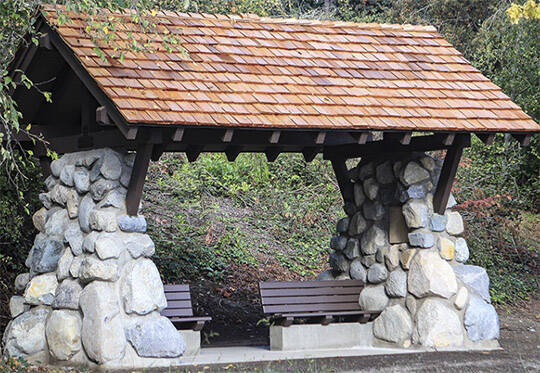Bainbridge Island has a new park feature inspired by an old era—a rock-and-timber bench shelter at Pritchard Park.
Nestled into the bluff overlooking the mouth of Eagle Harbor and west toward the Seattle skyline the rustic shelter is crafted from local materials, a BI Parks & Trails Foundation news release says.
“We hadn’t built a structure like this, basically a small bench-shelter combination,” said David Harry, Park Services superintendent for BI Metro Parks and Recreation and the shelter’s co-designer. “We’ve got benches all over the place with no roof over them. We’ve got shelters much larger than this but with picnic tables inside. It’s a new concept for us, but in the 1930s, these structures were built all over the U.S.”
The memorial shelter was privately funded by the Parsons family, in honor of their daughter Carrie and other families who have prematurely lost their children.
Harry knew the vernacular of the period well, having supervised restoration and construction at historic Crater Lake National Park in the 1990s. While there, he learned from one of the park’s original stone masons, who came from Italy in the 1920s, plied his craft at Crater Lake through the Civilian Conservation Corps years, and still lived in the area.
“He showed us the innuendos in a stone wall that you don’t know until you build one,” Harry said, “placement of rock, how to break up joints and add interest with the stones selectively placed.”
Designed by Harry and Doug Slingerland, the park district’s creative manager, the Pritchard Park shelter is buttressed by two tapered columns of regionally sourced rock, each stone hefted into place by the construction team and mortared secure. Three cedar trusses, milled from nuisance trees harvested at Hidden Cove Park, span the seating area. The shelter is crowned by a pitched, cedar shake roof.
Handcrafted wooden benches are contoured into the columns at each end. The area between the benches is open, so someone visiting in a wheelchair will have the very best seat.
The work uncovered evidence of Pritchard Park’s past as the community of Creosote. Dozens of row houses, stores and other structures once lined the hillside, a company town built around a sprawling plant that turned out treated pilings for most of the last century. Site work uncovered concrete steps and footings.
“It’ll become pretty iconic to the park and to the island itself,” Harry said. “I’d like to build more of these, but you have to be very careful about where you put them. You don’t want too many, and you want them in the right places. Very special, very select places.”



